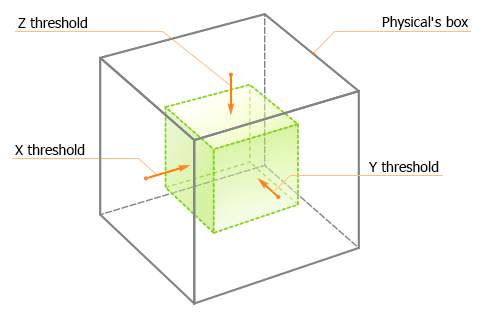Warning! This version of documentation is OUTDATED, as it describes an older SDK version! Please switch to the documentation for the latest SDK version.
Unigine::PhysicalWind Class
| Header: | #include <UniginePhysicals.h> |
| Inherits: | Physical |
A PhysicalWind class is used to simulate a box-shaped area inside of which the wind is blowing. The wind gradually decreases up to the box boundaries.
Notice
A physical wind will affect only an object that meets the following requirements:
- The object's bounds must be inside the physical wind box.
- A cloth body or a rigid body must be assigned to the object. If the rigid body is used, a shape should be also assigned.
See Also#
- An article on Physical Wind
- A set of samples located in the <UnigineSDK>/data/samples/physicals folder:
- wind_00
- wind_01
- wind_02
- wind_03
- wind_04
- wind_05
PhysicalWind Class
Members
static PhysicalWindPtr create ( const Math::vec3 & size ) #
Constructor. Creates a physical wind node of the specified size.Arguments
- const Math::vec3 & size - Wind box size in units.
void setAngularDamping ( float damping ) #
Sets a value indicating how much the angular velocity of the objects decreases when they get inside the wind node.Arguments
- float damping - Angular damping value. If a negative value is provided, 0 will be used instead.
float getAngularDamping ( ) #
Returns the current value indicating how much the angular velocity of the objects decreases when they get inside the physical wind node.Return value
Angular damping value.void setLinearDamping ( float damping ) #
Sets a value indicating how much the linear velocity of the objects decreases when they get inside the wind node.Arguments
- float damping - Linear damping value. If a negative value is provided, 0 will be used instead.
float getLinearDamping ( ) #
Returns the current value indicating how much the linear velocity of the objects decreases when they get inside the wind node.Return value
Linear damping value.void setSize ( const Math::vec3 & size ) #
Sets the size of the physical wind node.Arguments
- const Math::vec3 & size - Wind box size in units.
Math::vec3 getSize ( ) #
Returns the current size of the physical wind node.Return value
Wind box size in units.void setThreshold ( const Math::vec3 & threshold ) #
Sets the threshold distance values along the coordinates axes relative to the wind node size (that is, inside of it). It determines the area of gradual change from zero to full wind velocity.The threshold distance values form an invisible box, inside which the wind blows with full velocity:

Arguments
- const Math::vec3 & threshold - Threshold distance in units.
Math::vec3 getThreshold ( ) #
Returns the current threshold distance values along the coordinates axes relative to the wind node size (that is, inside of it). It determines the area of gradual change from zero to full wind velocity. See also setThreshold().Return value
Threshold distance in units.void setVelocity ( const Math::vec3 & velocity ) #
Sets the velocity of the physical wind flow along the axes.Arguments
- const Math::vec3 & velocity - Velocity in units per second.
Math::vec3 getVelocity ( ) #
Returns the current velocity of the physical wind flow along the axes.Return value
Velocity in units per second.static int type ( ) #
Returns the type of the node.Return value
Physical type identifier.Last update:
2020-11-24
Help improve this article
(or select a word/phrase and press Ctrl+Enter)